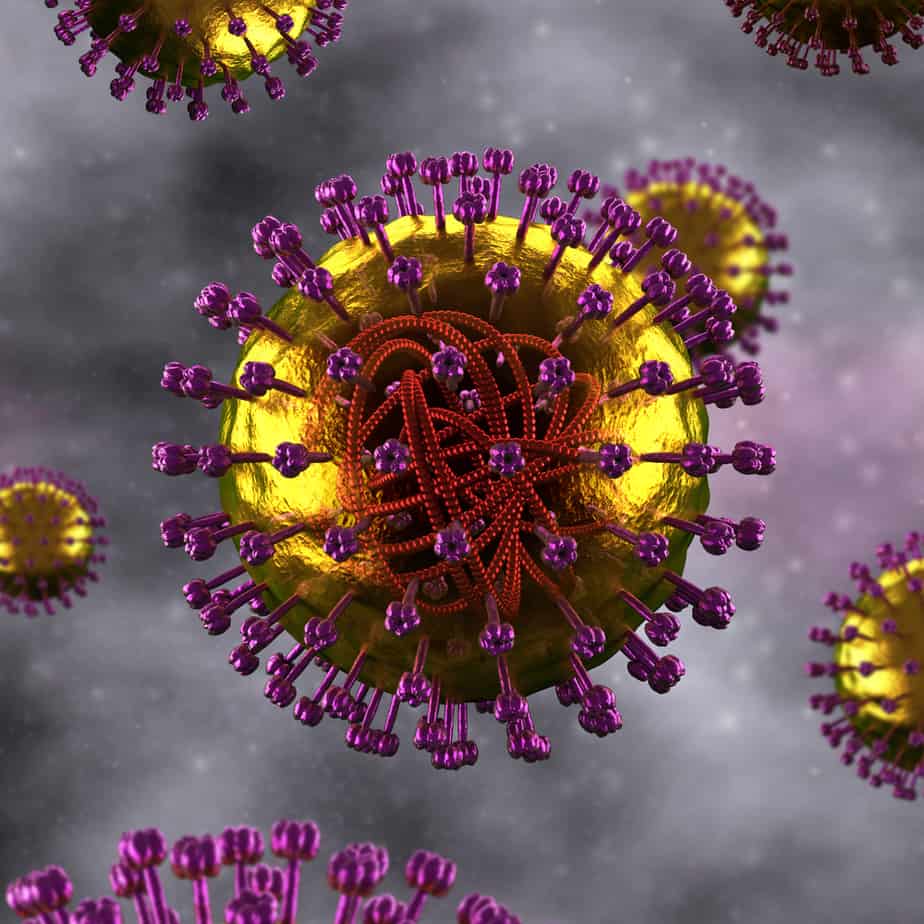
A Short History
Measles was identified as the result of a virus in the 18th century, but it was first mentioned in the 9th century by a Persian doctor. By 1912, measles was a notifiable disease in the US so all diagnosed cases were reported – in the first decade of reporting, there were about 60,000 reported deaths from measles.
Until 1963, when a vaccine first became available, almost all children had been infected with measles by the time they were 15, meaning about 4 million people were infected each year. Research for a vaccine began in 1954 by collecting blood samples from the blood of ill adolescents until measles was isolated.
The first vaccine in 1963 was replaced by a weaker vaccine in 1968, the Edmonston-Enders strain, and has been the only vaccine used ever since. The vaccine is typically combined with mumps and rubella (MMR).
The CDC made a goal to eliminate measles in the US by 1982 – measles rates vastly declined, but weren’t entirely eliminated until a second dose of MMR started being given. The first dose is recommended at 12-15 months of age, then the second when the child is 4-6 years old.
In 2000, measles was declared eliminated in the US. While reported cases stayed low from 2000-2010, the average number of cases has jumped up to 205 in recent years. So far in 2019, there have been the most cases reported since 1992, before measles was declared eliminated.
In 2017, over 100,000 people (mostly young children) around the world died from measles. It’s estimated that the measles vaccination has prevented 21.1 million deaths between 2000 and 2017.
Until 1963, when a vaccine first became available, almost all children had been infected with measles by the time they were 15, meaning about 4 million people were infected each year. Research for a vaccine began in 1954 by collecting blood samples from the blood of ill adolescents until measles was isolated.
The first vaccine in 1963 was replaced by a weaker vaccine in 1968, the Edmonston-Enders strain, and has been the only vaccine used ever since. The vaccine is typically combined with mumps and rubella (MMR).
The CDC made a goal to eliminate measles in the US by 1982 – measles rates vastly declined, but weren’t entirely eliminated until a second dose of MMR started being given. The first dose is recommended at 12-15 months of age, then the second when the child is 4-6 years old.
In 2000, measles was declared eliminated in the US. While reported cases stayed low from 2000-2010, the average number of cases has jumped up to 205 in recent years. So far in 2019, there have been the most cases reported since 1992, before measles was declared eliminated.
In 2017, over 100,000 people (mostly young children) around the world died from measles. It’s estimated that the measles vaccination has prevented 21.1 million deaths between 2000 and 2017.
Signs and Symptoms
After getting infected by the measles virus, symptoms start appearing within one to two weeks. Before symptoms start, a person can be infected and not even know it. The symptoms include high fever (getting to more than 104 degrees and making it very dangerous for young children and babies), cough, runny nose, and red watery (inflamed) eyes.
Within a couple days of symptoms appearing, Koplik spots sometimes appear in the mouth – these are tiny white spots. The next symptom to appear is the measles rash, small raised bumps that may join together and start on the face then move down the body all the way down to the feet.
Measles is known as one of the world’s most contagious diseases. Once infected, measles is contagious for about eight days – four days before the rash appears (and symptoms have started), and four days after the rash has appeared. Measles is spread through the virus in the nose and throat, so from coughing, sneezing, or talking. Other people breathe in the infected droplets from the air, or from touching a surface that has been contaminated by the droplets.
It is estimated that 90% of people who are susceptible to measles and get exposed to the virus will get infected. Measles epidemics are especially fatal in developing countries and in countries recovering from a natural disaster or a conflict.
Measles can result in complications, including an ear infection, inflammation of the lungs leading to bronchitis or croup, pneumonia (especially for someone who contracts measles with an already compromised immune system), blindness, and encephalitis (1 in 1,000 cases of measles).
Within a couple days of symptoms appearing, Koplik spots sometimes appear in the mouth – these are tiny white spots. The next symptom to appear is the measles rash, small raised bumps that may join together and start on the face then move down the body all the way down to the feet.
Measles is known as one of the world’s most contagious diseases. Once infected, measles is contagious for about eight days – four days before the rash appears (and symptoms have started), and four days after the rash has appeared. Measles is spread through the virus in the nose and throat, so from coughing, sneezing, or talking. Other people breathe in the infected droplets from the air, or from touching a surface that has been contaminated by the droplets.
It is estimated that 90% of people who are susceptible to measles and get exposed to the virus will get infected. Measles epidemics are especially fatal in developing countries and in countries recovering from a natural disaster or a conflict.
Measles can result in complications, including an ear infection, inflammation of the lungs leading to bronchitis or croup, pneumonia (especially for someone who contracts measles with an already compromised immune system), blindness, and encephalitis (1 in 1,000 cases of measles).
Diagnosis and Treatment
Typically, a doctor wil Measles is typically diagnosed by the rash or Koplik’s spots. There is no specific treatment for measles, which is why the vaccine is recommended.
Treatment is focused on easing symptoms, including reducing the fever with over-the-counter medications, antibiotics (if an ear infection or pneumonia also develops), and providing Vitamin A to children with low levels – Vitamin A has been shown to help reduce eye damage and blindness from measles.
It’s important to stay hydrated while sick and rest. A humidifier may help a cough or sore throat. Since the eyes are affected from measles, it’s recommended to keep the lights low or wear sunglasses.
Treatment is focused on easing symptoms, including reducing the fever with over-the-counter medications, antibiotics (if an ear infection or pneumonia also develops), and providing Vitamin A to children with low levels – Vitamin A has been shown to help reduce eye damage and blindness from measles.
It’s important to stay hydrated while sick and rest. A humidifier may help a cough or sore throat. Since the eyes are affected from measles, it’s recommended to keep the lights low or wear sunglasses.
Prevention
The MMR vaccine, when given in two doses, is 97% effective at preventing measles when exposed to the virus. The majority of people who are infected with measles are unvaccinated, and is typically spread by travel, especially if an infected person goes to a community with higher number of unvaccinated people.
Measles is still a concern in the US due to travelers bringing in the disease. Anyone un-vaccinated is likely to get it when exposed, and risks infecting those with compromised immune symptoms or who are still too young to get the vaccine.
If someone didn’t get the vaccine as a child, they can still receive both doses as an adult – the first dose is given, then a month later they can get the second dose. This is the best way to prevent the disease.
Measles is still a concern in the US due to travelers bringing in the disease. Anyone un-vaccinated is likely to get it when exposed, and risks infecting those with compromised immune symptoms or who are still too young to get the vaccine.
If someone didn’t get the vaccine as a child, they can still receive both doses as an adult – the first dose is given, then a month later they can get the second dose. This is the best way to prevent the disease.
Sources and More Information
Centers for Disease Control and Prevention, “Measles (Rubeola)” – “Measles History” https://www.cdc.gov/measles/about/history.html
CDC, “Measles (Rubeola)” – “Signs and Symptoms” https://www.cdc.gov/measles/symptoms/signs-symptoms.html?CDC_AA_refVal=https%3A%2F%2Fwww.cdc.gov%2Fmeasles%2Fabout%2Fsigns-symptoms.html
Mayo Clinic, “Measles” https://www.mayoclinic.org/diseases-conditions/measles/symptoms-causes/syc-20374857
World Health Organization, “Measles” https://www.who.int/news-room/fact-sheets/detail/measles
CDC, “Measles (Rubeola)” – “Signs and Symptoms” https://www.cdc.gov/measles/symptoms/signs-symptoms.html?CDC_AA_refVal=https%3A%2F%2Fwww.cdc.gov%2Fmeasles%2Fabout%2Fsigns-symptoms.html
Mayo Clinic, “Measles” https://www.mayoclinic.org/diseases-conditions/measles/symptoms-causes/syc-20374857
World Health Organization, “Measles” https://www.who.int/news-room/fact-sheets/detail/measles


